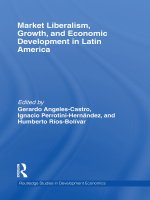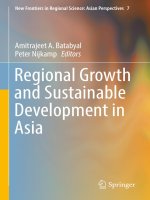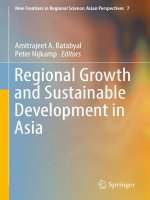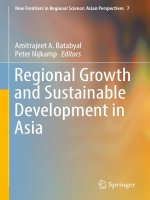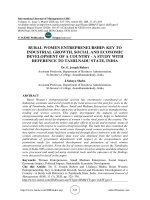Economic growth and economic development 75
Bạn đang xem bản rút gọn của tài liệu. Xem và tải ngay bản đầy đủ của tài liệu tại đây (102.62 KB, 1 trang )
Introduction to Modern Economic Growth
2.3. Transitional Dynamics in the Discrete Time Solow Model
Proposition 2.2 establishes the existence of a unique steady-state equilibrium
(with positive activity). Recall, however, that an equilibrium path does not refer
simply to the steady state, but to the entire path of capital stock, output, consumption and factor prices. This is an important point to bear in mind, especially since
the term “equilibrium” is used differently in economics than in physical sciences.
Typically, in engineering and physical sciences, an equilibrium refers to a point of
rest of a dynamical system, thus to what we have so far referred to as the steady state
equilibrium. One may then be tempted to say that the system is in “disequilibrium”
when it is away from the steady state. However, in economics, the non-steady-state
behavior of an economy is also governed by optimizing behavior of households and
firms and market clearing. Most economies spend much of their time in non-steadystate situations. Thus we are typically interested in the entire dynamic equilibrium
path of the economy, not just its steady state.
To determine what the equilibrium path of our simple economy looks like we
need to study the “transitional dynamics” of the equilibrium difference equation
(2.16) starting from an arbitrary capital-labor ratio, k (0) > 0. Of special interest
is the answer to the question of whether the economy will tend to this steady state
starting from an arbitrary capital-labor ratio, and how it will behave along the
transition path. It is important to consider an arbitrary capital-labor ratio, since,
as noted above, the total amount of capital at the beginning of the economy, K (0),
is taken as a state variable, while for now, the supply of labor L is fixed. Therefore,
at time t = 0, the economy starts with k (0) = K (0) /L as its initial value and
then follows the law of motion given by the difference equation (2.16). Thus the
question is whether the difference equation (2.16) will take us to the unique steady
state starting from an arbitrary initial capital-labor ratio.
Before doing this, recall some definitions and key results from the theory of
dynamical systems. Consider the nonlinear system of autonomous difference equations,
(2.23)
x (t + 1) = G (x (t)) ,
61
